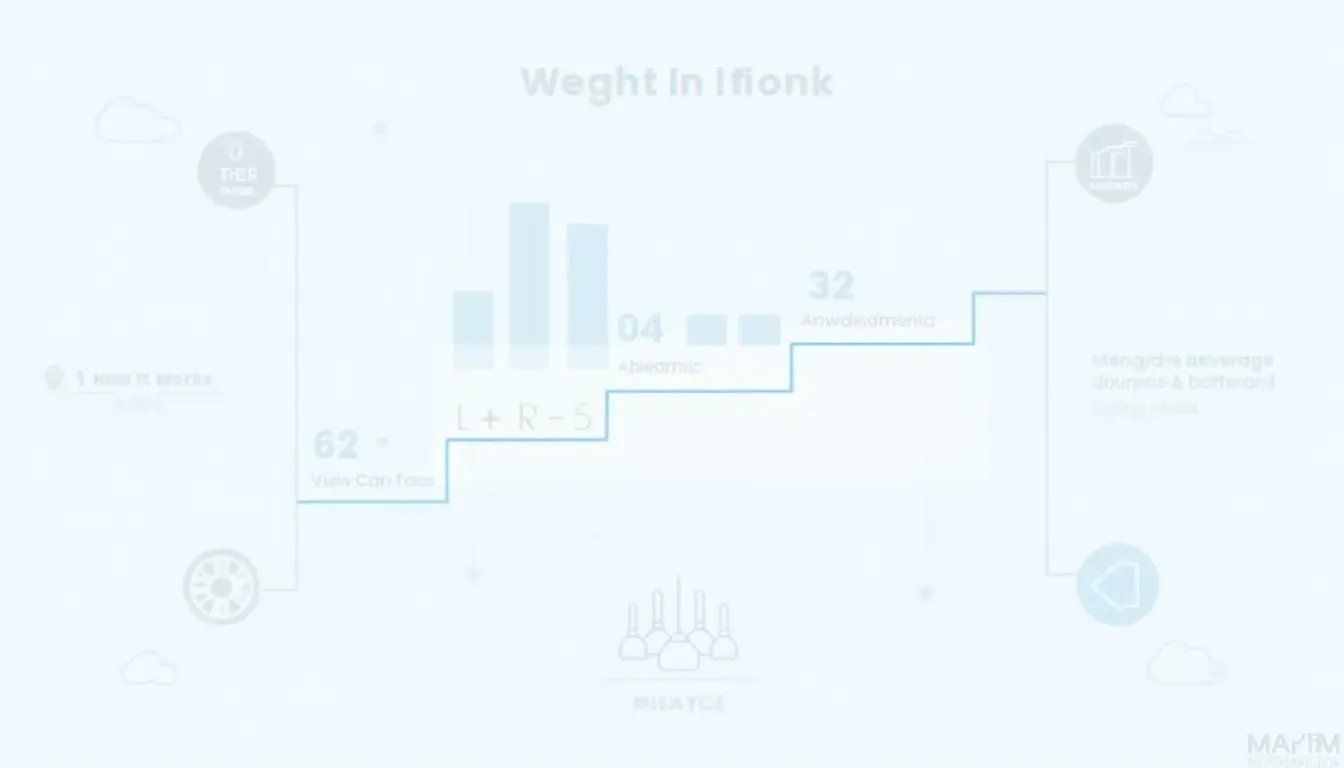Weighted Average Calculator
Is this tool helpful?
How to Use the Weighted Average Calculator Effectively
Our Weighted Average Calculator is designed to simplify complex data analysis by providing a user-friendly interface for calculating weighted averages. Here’s a step-by-step guide on how to use this powerful tool effectively:
- Enter Assigned Weights: In the first input field, enter the weights for each data point, separated by spaces. For example, if you have three data points with weights of 2, 3, and 5, you would enter “2 3 5”.
- Input Data Points: In the second field, enter the corresponding data point values, also separated by spaces. For instance, if your data points are 10, 20, and 30, you would enter “10 20 30”.
- Calculate: Click the “Calculate” button to process your input and generate the weighted average.
- View Results: The calculated weighted average will be displayed below the form, providing you with an accurate and instant result.
It’s important to ensure that the number of weights matches the number of data points. If there’s a mismatch or if you enter invalid numbers, the calculator will display an error message to guide you in correcting your input.
Understanding Weighted Averages: Definition, Purpose, and Benefits
A weighted average is a calculation that takes into account the varying degrees of importance of the numbers in a data set. Unlike a simple arithmetic mean, where each number carries equal significance, a weighted average assigns different weights or levels of importance to each value.
The purpose of using a weighted average is to provide a more accurate representation of data when certain values are more significant than others. This method of calculation is particularly useful in various fields, including finance, statistics, data analysis, and decision-making processes.
The Mathematical Formula for Weighted Average
The weighted average is calculated using the following formula:
$$ \text{Weighted Average} = \frac{\sum_{i=1}^{n} w_i x_i}{\sum_{i=1}^{n} w_i} $$Where:
- $$w_i$$ represents the weight of the $$i$$-th item
- $$x_i$$ represents the value of the $$i$$-th item
- $$n$$ is the total number of items
Key Benefits of Using the Weighted Average Calculator
Our Weighted Average Calculator offers numerous advantages for individuals and professionals dealing with complex data sets:
- Time-Saving: Eliminate manual calculations and reduce the risk of human error.
- Accuracy: Ensure precise results with our reliable algorithm.
- User-Friendly Interface: Easily input your data without the need for complex spreadsheets or formulas.
- Instant Results: Obtain your weighted average immediately after entering your data.
- Versatility: Applicable to various fields and scenarios where weighted averages are necessary.
- Educational Tool: Helps students and professionals understand the concept of weighted averages through practical application.
Addressing User Needs and Solving Specific Problems
The Weighted Average Calculator is designed to address several common challenges faced by individuals working with complex data sets:
1. Simplifying Complex Calculations
Calculating weighted averages manually can be time-consuming and prone to errors, especially when dealing with large data sets. Our calculator automates this process, allowing users to focus on interpreting results rather than getting bogged down in calculations.
2. Enhancing Decision-Making Processes
In many scenarios, not all data points carry equal importance. By using weighted averages, decision-makers can account for varying levels of significance in their data, leading to more informed and accurate conclusions.
3. Improving Academic Performance
Students often struggle with the concept of weighted averages in mathematics and statistics courses. This calculator serves as a practical tool for verifying homework solutions and gaining a deeper understanding of the underlying principles.
4. Streamlining Financial Analysis
In finance, weighted averages are crucial for portfolio management, risk assessment, and performance evaluation. Our calculator simplifies these processes, enabling financial professionals to make quicker, more accurate assessments.
5. Enhancing Data Interpretation
Researchers and data analysts can use this tool to derive more meaningful insights from their data by assigning appropriate weights to different variables or observations.
Practical Applications and Use Cases
The Weighted Average Calculator has a wide range of practical applications across various fields. Here are some examples to illustrate its versatility:
1. Academic Grading Systems
Many educational institutions use weighted averages to calculate final grades. For instance, a course might assign different weights to assignments, midterms, and final exams:
- Assignments (30% weight): 85, 90, 88
- Midterm Exam (30% weight): 78
- Final Exam (40% weight): 92
Using our calculator, you can easily determine the final grade by entering:
Weights: 30 30 40
Values: 87.67 78 92
The resulting weighted average would represent the student’s final grade for the course.
2. Investment Portfolio Analysis
Financial advisors and investors use weighted averages to evaluate portfolio performance. For example, if an investor has three stocks in their portfolio:
- Stock A (50% of portfolio): 8% return
- Stock B (30% of portfolio): 5% return
- Stock C (20% of portfolio): 12% return
By entering these values into our calculator (Weights: 50 30 20, Values: 8 5 12), you can quickly determine the overall portfolio return.
3. Customer Satisfaction Surveys
Businesses often use weighted averages to analyze customer feedback. Different aspects of a product or service may be assigned varying levels of importance:
- Product Quality (weight 5): Rating 4.2
- Customer Service (weight 3): Rating 3.8
- Price (weight 2): Rating 3.5
Using our calculator with these inputs (Weights: 5 3 2, Values: 4.2 3.8 3.5) would provide an overall weighted satisfaction score.
4. Employee Performance Evaluations
Human Resource departments may use weighted averages to assess employee performance across multiple criteria:
- Job Knowledge (weight 4): Score 9
- Communication Skills (weight 3): Score 8
- Teamwork (weight 2): Score 7
- Punctuality (weight 1): Score 10
Inputting these values into our calculator would yield a comprehensive performance score.
5. Quality Control in Manufacturing
Manufacturers often use weighted averages to assess product quality. Different aspects of a product may have varying importance:
- Durability (weight 5): Score 9.5
- Appearance (weight 3): Score 8.7
- Packaging (weight 2): Score 9.2
Our calculator can quickly compute an overall quality score for the product.
Frequently Asked Questions (FAQ)
1. What is a weighted average, and how does it differ from a simple average?
A weighted average takes into account the varying importance of each value in a data set by assigning weights to each value. In contrast, a simple average treats all values equally. Weighted averages provide a more accurate representation when some data points are more significant than others.
2. Can I use decimal numbers for weights or values?
Yes, our calculator supports both integer and decimal inputs for weights and values. Simply enter the numbers as you would normally, separating them with spaces.
3. Is there a limit to how many weights and values I can enter?
While there’s no strict limit, the calculator is designed to handle a reasonable number of inputs. For very large data sets, you may want to consider using specialized statistical software.
4. What happens if I enter a different number of weights and values?
The calculator will display an error message if the number of weights doesn’t match the number of values. Ensure that you have the same number of entries for both inputs.
5. Can I use negative numbers as weights or values?
Yes, the calculator can handle negative numbers for both weights and values. However, be cautious when using negative weights, as they can lead to counterintuitive results.
6. How accurate is the Weighted Average Calculator?
Our calculator uses standard JavaScript arithmetic operations and should provide results accurate to several decimal places. However, for applications requiring extreme precision, you may want to verify results with specialized scientific calculators.
7. Can this calculator be used for financial calculations?
While the calculator can be used for basic financial calculations involving weighted averages, it’s important to note that complex financial analyses may require more specialized tools that account for additional factors.
8. Is my data saved or stored when I use this calculator?
No, all calculations are performed client-side in your browser. We do not store or transmit any of the data you enter.
9. How can I report an issue or suggest an improvement?
If you encounter any issues or have suggestions for improving the calculator, please contact our support team through the provided channels on our website.
10. Is this calculator suitable for educational purposes?
Yes, this calculator can be an excellent educational tool for students learning about weighted averages. However, we recommend using it in conjunction with manual calculations to ensure a thorough understanding of the concept.
Please note that while we strive for accuracy and reliability, we cannot guarantee that the webtool or results from our webtool are always correct, complete, or reliable. Our content and tools might have mistakes, biases, or inconsistencies. Always verify important calculations with multiple sources or consult with a qualified professional when necessary.
Conclusion: Harness the Power of Weighted Averages
The Weighted Average Calculator is an invaluable tool for anyone dealing with complex data sets where not all values carry equal importance. By simplifying the calculation process, this tool enables users to:
- Save time and reduce errors in calculations
- Make more informed decisions based on accurate data analysis
- Gain deeper insights into their data by accounting for varying levels of importance
- Improve academic performance and understanding of statistical concepts
- Enhance financial analysis and portfolio management
Whether you’re a student, financial professional, researcher, or business analyst, our Weighted Average Calculator provides a user-friendly solution to your data analysis needs. By leveraging this powerful tool, you can streamline your workflow, improve the accuracy of your results, and make more informed decisions based on weighted data.
Don’t let complex calculations slow you down or introduce errors into your analysis. Try our Weighted Average Calculator today and experience the benefits of quick, accurate, and insightful data analysis. Your data-driven decisions are just a few clicks away!
Important Disclaimer
The calculations, results, and content provided by our tools are not guaranteed to be accurate, complete, or reliable. Users are responsible for verifying and interpreting the results. Our content and tools may contain errors, biases, or inconsistencies. We reserve the right to save inputs and outputs from our tools for the purposes of error debugging, bias identification, and performance improvement. External companies providing AI models used in our tools may also save and process data in accordance with their own policies. By using our tools, you consent to this data collection and processing. We reserve the right to limit the usage of our tools based on current usability factors. By using our tools, you acknowledge that you have read, understood, and agreed to this disclaimer. You accept the inherent risks and limitations associated with the use of our tools and services.







